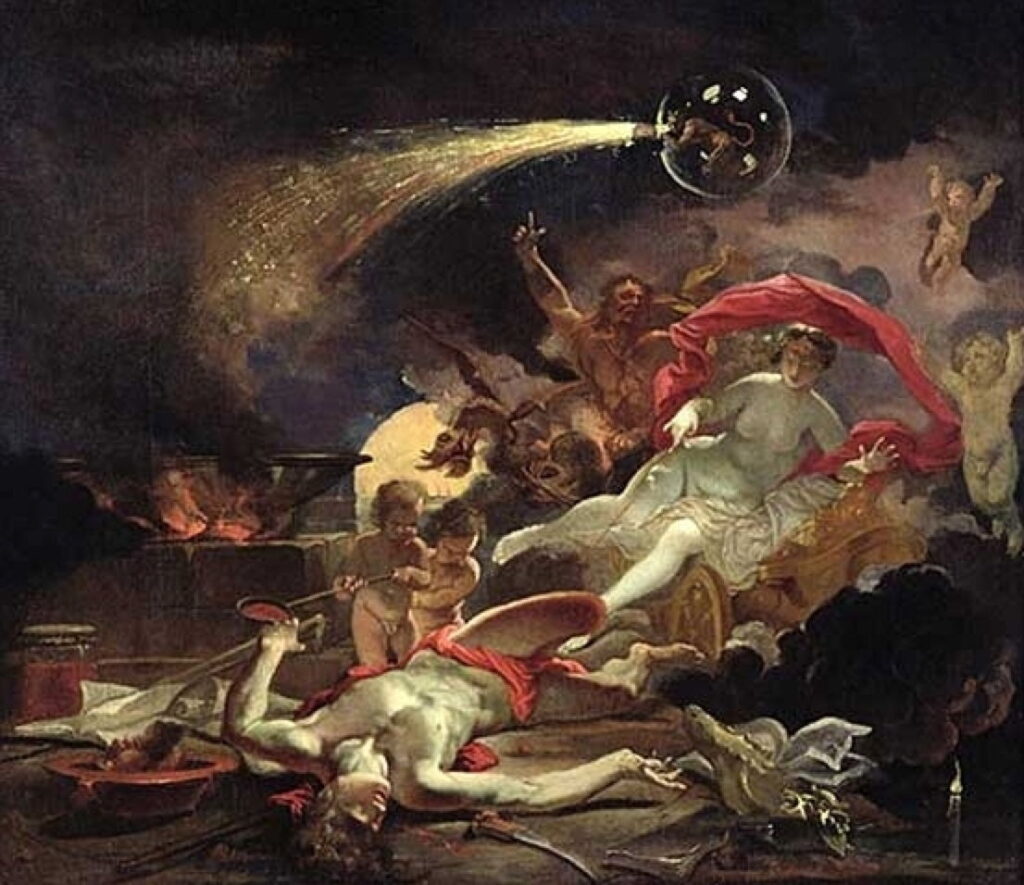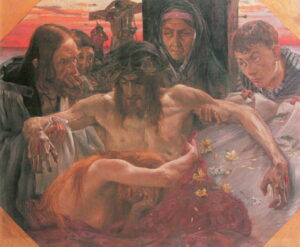Changing Paintings: 31 Rejuvenating Aeson

Following Ovid’s brief summary of the adventure of Jason and the Golden Fleece, Book 7 of Metamorphoses continues his account of Jason and Medea with an unusual myth about human rejuvenation. Once Jason and his Argonauts had returned to their homes, there was much celebratory feasting, but one person was unable to take part: Jason’s father Aeson, who was too old and nearing death. Jason therefore asks his new wife Medea if she can transfer some of his own youth to extend his father’s years.
Medea initially chides Jason for suggesting such an act forbidden by Hecate as the goddess of witchcraft and sorcery, but then tells him that she will go one better, and try to rejuvenate Aeson without using any of Jason’s future life.
For three nights Medea engages in rituals to seek Hecate’s help, and the goddess sends down her chariot to help her prepare for the task. The sorceress then takes that chariot in her quest for the ingredients required for her magic potion. For nine days and nights, Medea flies around gathering herbs and other arcane substances from all over the world.
She then builds two turf altars and slaughters a sheep before starting to prepare the potion. She calls for Aeson to be brought out to her, and uses a spell to put him to sleep on a bed of magic herbs before dismissing Jason and others. She purges Aeson’s body with water, sulphur, and fire, while her potion is brewing in a cauldron. Where it bubbles over the side, luxuriant plants and flowers sprout up immediately.
Medea finally cuts Aeson’s throat to let all his old blood out and replaces it with her potion. The old man is immediately transformed back to his youth, his thinning white hair replaced by a rich growth of dark locks from someone forty years younger. Bacchus, who has been watching from heaven, asks for the recipe so he can rejuvenate his own nurses.
Pellegrino Tibaldi (1527–1596), Medea Rejuvenates Aeson (date not known), fresco, dimensions not known, Palazzo Marescalchi, Bologna, Italy. Wikimedia Commons.
This monochrome image is the only one available of Pellegrino Tibaldi’s fresco of Medea Rejuvenates Aeson, which he painted in the latter half of the sixteenth century. Medea, naked as became traditional in depictions of witchcraft, is shown purging Aeson’s body with water. Pellegrino relocates the event from outdoor turf altars to a more substantial indoor stone trough, around which are scattered jugs and other remnants from Medea’s sorcery. At Aeson’s feet are statues, the most prominent of which shows Hecate.
Domenicus van Wijnen (1661- c 1695), Medea Rejuvenating Aeson (date not known), oil on canvas, 46 × 53 cm, Musée des beaux-arts de Pau, Pau, France. Wikimedia Commons.
About a century later, Domenicus van Wijnen painted his Medea Rejuvenating Aeson (late seventeenth century), invoking alchemy as well as witchcraft. Medea, naked again and reclining in Hecate’s golden chariot, points her wand at the body of Aeson lying on the ground as she casts a spell. A glass sphere above her contains a small devil and shoots a trail of flame and sparks like a rocket. Medea is assisted by four putti and has what appears to be Hecate herself behind her, and a full moon is seen rising above the horizon. Scattered around the scene are objects associated with witchcraft, including a glass cauldron, a jar of brown liquid, a sacrificial knife, old books, and a burning candle.
Bartolomeo Guidobono (1654–1709), Medea Rejuvenates Aeson (c 1700), oil on canvas, 173 x 212 cm, Private collection. Wikimedia Commons.
Bartolomeo Guidobono’s Medea Rejuvenates Aeson from about 1700 is more of a puzzle to read, as Medea, dressed in an unkempt and wild manner, is here accompanied by two men. The near-lifeless and pale body of Aeson rests behind her, but a younger man, possibly the rejuvenated Aeson, is materialising under a table.
There’s a panoply of symbols associated with magic, including a snake and toad, large tomes of spells on top of which is a lizard, an open fire on a small stand, and an assortment of more normal animals including a dog, fox, and deer. The table in the background has further magic equipment, such as an orrery, and a bat is flying to the right of Medea’s head.
Corrado Giaquinto (1703–1765), Medea Rejuvenating Aeson (1760), oil on canvas, 73.7 x 54.6 cm, Metropolitan Museum of Art, New York, NY. Wikimedia Commons.
Corrado Giaquinto’s splendid Medea Rejuvenating Aeson from 1760 is more theatrical. Set outdoors by the arches of a large stone structure, three gods watch Medea work her spells. At the front of the trio is Diana, wearing a crescent moon as a diadem. To the right is Neptune with his spiked crown and trident, and to the left is (probably) Hecate.
Medea stands in the midst of casting a spell, her wand held over the inert body of Aeson, which rests on a bed of flowers and leaves. Behind that is a more Christian-looking altar, with candles burning at its sides. There is a cauldron heating over an open fire at the bottom right, and the body of a black sheep on a more classical altar to the left.
Sorcery and witchcraft became increasingly popular in the late eighteenth century as themes for painting and other arts, with some innovative works by Fuseli and others. Although those painters would have been well aware of this myth, the rejuvenation of Aeson doesn’t seem to have made its way onto canvas. Popular interest in ‘gothic’ stories of revivification was inspired by the publication in 1818 of Mary Shelley’s novel Frankenstein; or, The Modern Prometheus, but by this time narrative painting was in crisis, and Frankenstein’s monster doesn’t seem to have been depicted in painting until the twentieth century. By then Shelley’s story had already appeared in plays and movies.



